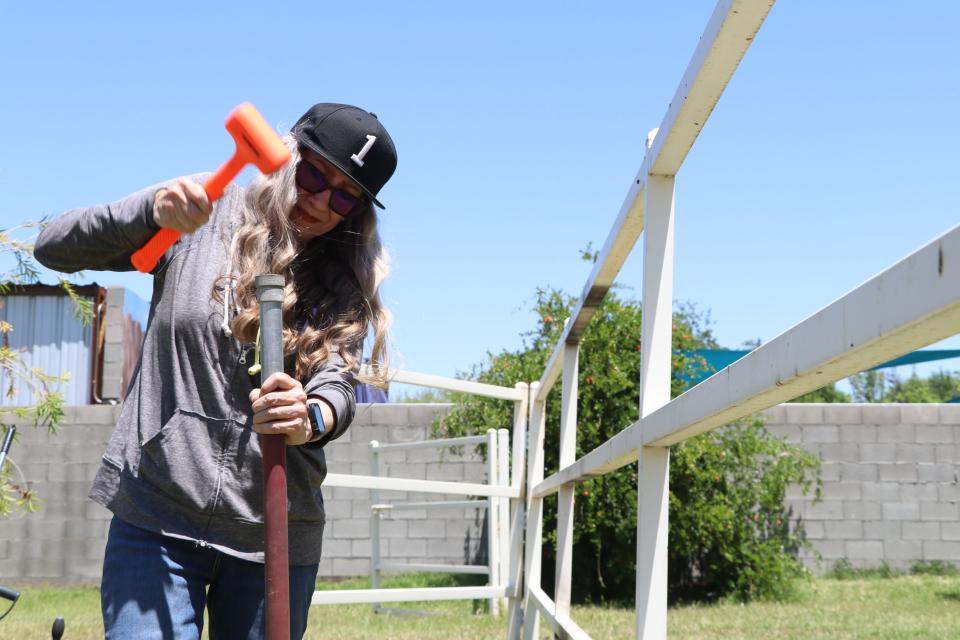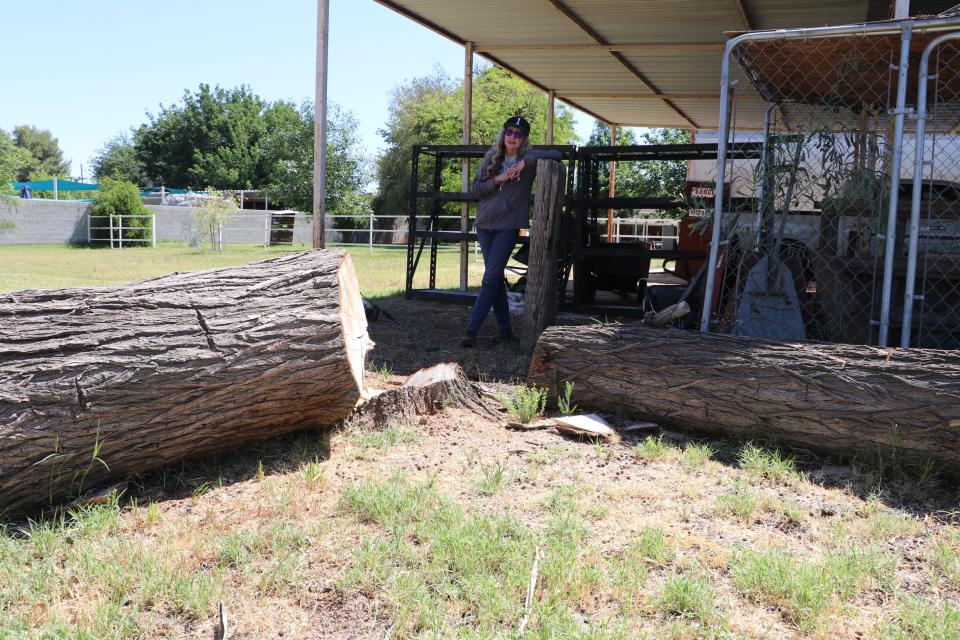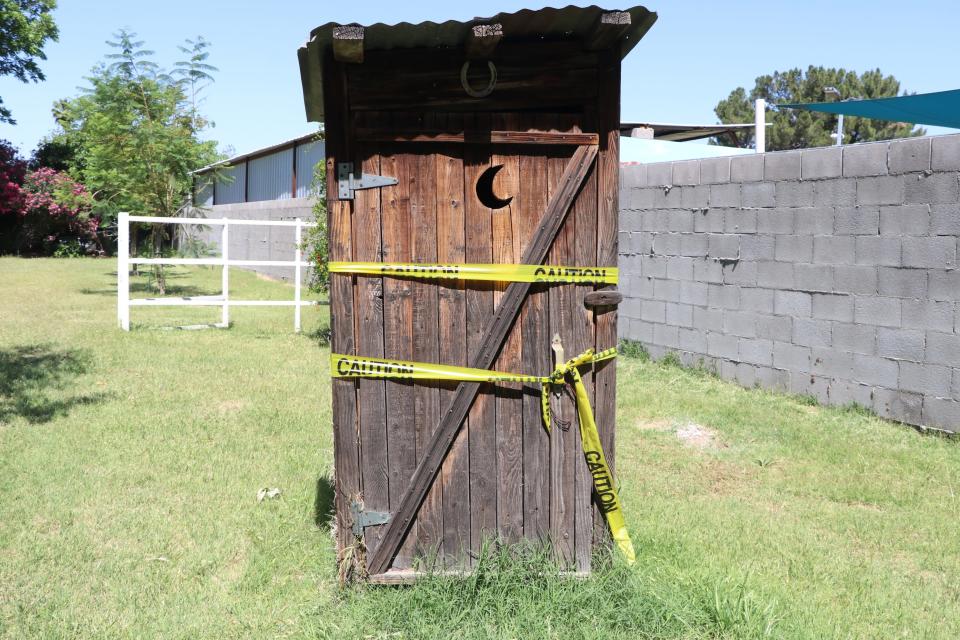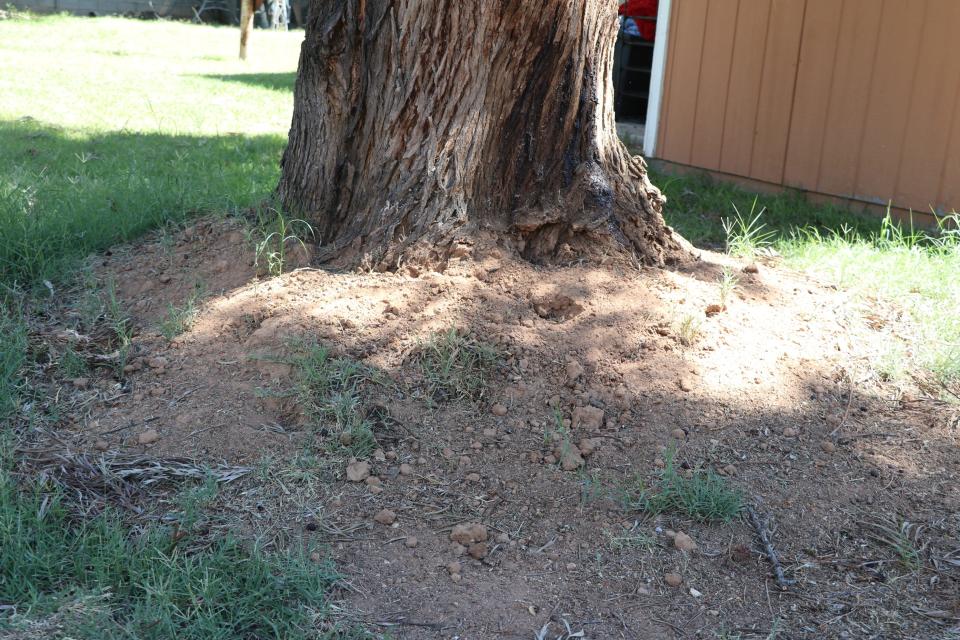'They’re just everywhere': Glendale deals with gopher infestation that has cost thousands in damages
Lori Dunkel spotted a dirt mound in her yard last fall. Next to it was another mound, and another one next to that.
“Wow, this is getting worse,” Dunkel recalled telling herself.
It was October, she remembered, as that was shortly after her husband had passed. He had been sick for months, staying in a hospital that he never left.
Thinking it would remove the mounds, she irrigated the yard on her 1-acre property in south Glendale, off 76th Lane and Camelback Road.
The mounds went away, but not for long.
“(Some) mounds are gone, but then over here there are mounds,” she said. Then she “started noticing them in the back, pretty much where you have vegetation, a tree.”
Dunkel spoke with neighbors, asking if they, too, were seeing dirt mounds. They confirmed they were finding mounds in their yards too.
She went online to learn more about these mounds, discovering they were the work of pocket gophers. As a former process engineer, Dunkel started researching solutions.

She tried various methods like irrigating her yard and gassing the gopher holes with the exhaust from her car. A neighbor tried poison pellets.
“It did not work, did not work, did not work,” she said, repeating herself for emphasis.
Noting that her daughter-in-law was pregnant, she wanted to avoid using other toxicants and pesticides, believing they could pose environmental hazards to the area and create other safety risks to her home.
Online, she found a device called a GopherHawk, which traps and humanely kills the rodent.
Over a few months, she set about 500 hundred traps and has caught 60 pocket gophers.
“I thought I was killing it, then I saw another hole … caught three little babies. They were four inches long,” she said.
A female pocket gopher can produce litters of about six pups.
“I realized that there were more of these types of little round circular areas,” she said. “I saw three of them. They were breeding dens, I had three of them within 20 feet of me. I literally panicked.”

How much damage have these gophers caused?
Pocket gophers grow to between 5 to 14 inches in length and use their strong front claws for digging holes and creating a tunnel system. It pushes soil to the surface to form mounds.
They’re herbivores, meaning they feast on plant roots.
While they can benefit ecosystems by transporting soil microbes, their eating habits make them “very destructive when they venture into gardens and landscapes,” according to researchers from the University of Arizona’s Cooperative Extension.
Dunkel’s neighborhood is lush with grass and large trees, creating an ideal environment for the rodents.
“It’s like breakfast, lunch and dinner,” Dunkel said of the 20-acre area that comprises her home, seven neighboring properties and the nearby Camelback Academy.
The roots of at least 16 trees in the neighborhood have already been eaten through, as evidenced by decaying and falling branches, Dunkel pointed out.
Dunkel’s property alone lost three trees, one of which she had removed. Another one near the center of her yard is in the process of dying.
“It’s just a matter of time until they either blow over or you have to take them down,” Dunkel said.
Under her house is where the gophers have caused the most damage. They ate through her water line, leading to costly repairs.
“I would flush the toilet and it didn’t go anywhere,” she said, noting that her plumber ran a camera through the sewer revealing it had been blocked with dirt. “They had to come in and dig holes in my house, pull new sewer veins, replumb everything.”
She spent about $5,000 to repair the sewer line and another $1,000 to fix the drywall. Then she spent another $20,000 on the new concrete and floor tiles.
“It’s overwhelming, and I know they’re still under there,” she said.

How pervasive is this issue?
Sandra Seino is an inspection specialist on pocket gophers. Her company, The Gopher Getters, has been trapping gophers in Arizona since 1966.
A comment Seino left on a Facebook group advising how to capture gophers caught Dunkel’s eye. So Dunkel contacted Seino directly, begging her to assess the situation.
Seino, according to Dunkel, was a bit reluctant at first because she was already busy with clients in the East Valley. There was also a concern of wrangling all the neighbors to agree to a meeting.
“It was so big, it was so far, and how do you manage all these people?” Dunkel said of Seino’s concerns. “I convinced her that I had a relationship with all my neighbors and that we were invested … I think it piqued her interest.”
On her day off, Seino met with Dunkel and most of the neighbors.
She arrived around 9 a.m. She didn’t leave until about 10 p.m.
Based on the mounds and the damaged trees in the neighborhood and at the school, Seino estimated there were easily more than 1,000 gophers burrowing in the area.
“They’re just everywhere,” Seino told The Arizona Republic, noting that there wasn’t a way to get an accurate account without pulling every gopher out. “Every single house has them. I didn’t see one home that doesn’t have it. It’s really that bad.”

Where did the gophers come from?
The problem, Seino said, isn’t unique to Dunkel’s area. “It’s like this everywhere.”
Seino said that’s partly because homeowners rely on improper pest control methods, like using pesticides and chemicals — practices she called “lazy.”
“They don't want to spend the time working it. They all want the easy way out. Just throw something at it, call it done,” Seino said.
Valley-wide, she added, developers have acquired agricultural land and ignored the gophers below before building and selling new homes.
In recent years, new housing developments have been constructed on what was agricultural land between Camelback and Bethany Home roads, just west of Dunkel’s neighborhood.
“The farmer should be clearing out that property (of gophers) before it's sold. And they're not,” Seino said. “And then here comes a developer and they should clear off that property of gophers … but they don't, and they break ground and the gophers scramble away.”
They scramble into the nearby neighborhoods, creating or expanding their tunnel system.
“These tunnels intersect with hundreds if not thousands of others, and they extend for miles,” Seino said. “And so, they go into abutted neighborhoods and homes, destroying their property.”
How do you get rid of gophers?
UA’s Cooperative Extension outlined several techniques people have used to kill or deter pocket gophers.
Those included irrigating yards and gassing the gopher holes — methods Dunkel tried with no success.
The UA extension agents noted that using gaseous toxicants “are variable in their effectiveness.” They also advised against using other toxicants like poison pellets on small properties.
“These toxicants can be inadvertently consumed by pets or other non-targeted animals,” the university agency said in an article titled "Managing Pocket Gophers."
The most effective strategy, the extension agents found, was trapping.
Seino staunchly agrees, calling it the “true way” because there's evidence that the rodent has been caught and killed.
“When it comes to the trapping … you gotta just have the right mindset. You got to get in there, you gotta work real hard and learn how to do this,” she said. “If you learn about the species first, you're ahead of the game by a mile and you will be successful.”
Trapping, she stressed, is also safer compared with other pest control methods like poisons, which are often intended for omnivores.
“People are buying products for the wrong species, and then they get frustrated because it's not working,” Seino said. “They're throwing away all their money and not having any success and their (gopher) population’s still growing.”
Setting gopher traps
UA’s Cooperative Extension advises using a two-trap system using body-gripping devices.
Seino said she uses the Victor Easy Set Gopher Trap but plans to bring her own device to the market.
In her yard, Dunkel had some success with the GopherHawk, a pole-like device that she sticks into a gopher hole to catch the rodent.
Initially, she would catch two for every nine traps. More recently, she’s gotten better, catching two for every five traps. Depending on how close her trap is to a gopher, she can catch one in 30 minutes; other times, it can take a few days, she said.
Seino said the GopherHawk is great at catching smaller gophers but is less effective in catching larger ones like the females.
It’s imperative to capture and humanely kill the pregnant females first, then the dormant females, Seino said.
“Once you have both under control, and they're all dead, and you start your perimeter, those males that are deep down into the ground, they're going to come out from that breeding den, looking for their females.”
Lack of a coordinated effort
Dunkel so far has spent $800 on just her traps. She’s used them to help her neighbors catch gophers in their yards.
Dunkel said her son and her friend plan to use Seino’s trapping method and devices, at least on her property. But ridding the neighborhood of the infestation requires more coordination as she and her neighbors, some of whom are in their 90s, can’t do it alone.
Dunkel has contacted the city of Glendale and the Arizona Game and Fish Department for help.
City officials haven’t responded to her.
In an email from Game and Fish Tuesday, a department spokesperson told The Republic it doesn’t manage pocket gophers, as they’re considered a pest control issue.
Glendale didn’t respond to a request seeking comment.
“Some sort of intervention needs to be done. How am I supposed to coordinate?” Dunkel said, adding, “They’re everywhere.”
Dunkel plans to host a community meeting for those in the Valley interested in learning more about managing pocket gophers. She said she’s coordinating with Seino to lead a section on trapping, and an expert from the University of Idaho to present information over Zoom.
For those interested in attending, Dunkel can be reached at lori.l.dunkel@googlemail.com.
This article originally appeared on Arizona Republic: Glendale neighborhood gears up to fight gopher infestation

